Master the art of sous vide salmon with our foolproof recipe! Unbelievable tenderness, moisture, and flavor, accompanied by an irresistible lemon dill sauce. Plus, tips when using frozen salmon!
You no longer have to worry about uneven cooking, overcooking, or carefully watching your delicate salmon, and I promise it will come out perfect every single time. Instead, use this sous vide recipe and enjoy restaurant-quality salmon filets!
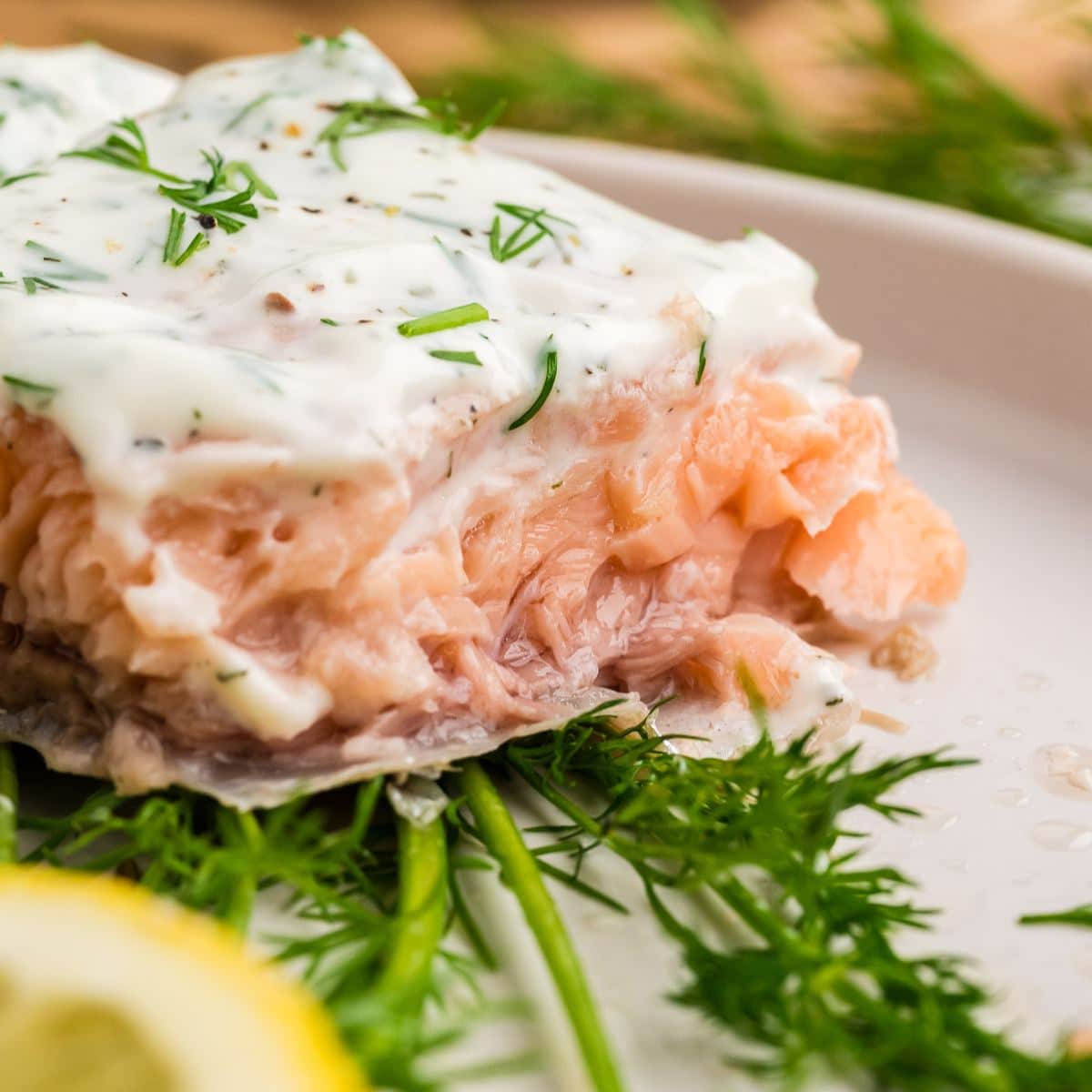
Why You Will Love this Sous Vide Salmon Recipe
- Homemade – With very little hands-on time, you will be amazed at the flavor of this salmon!
- Easy – One of my favorite parts of using the sous vide method of cooking is how you take a little time to prep, then while the salmon cooks you can prepare side dishes
- Fresh or Frozen – You can use fresh or frozen salmon fillets, depending on what you prefer or have on hand.
I enjoy giving precise details in my recipe posts to lead my readers through any questions. If you’re just here for the printable recipe, use the Jump to Recipe to head straight there!
This recipe works well for all types of salmon varieties!
A fantastic, low-carb main dish recipe! Chill and serve in salads, or eat warm with this creamy dill sauce.
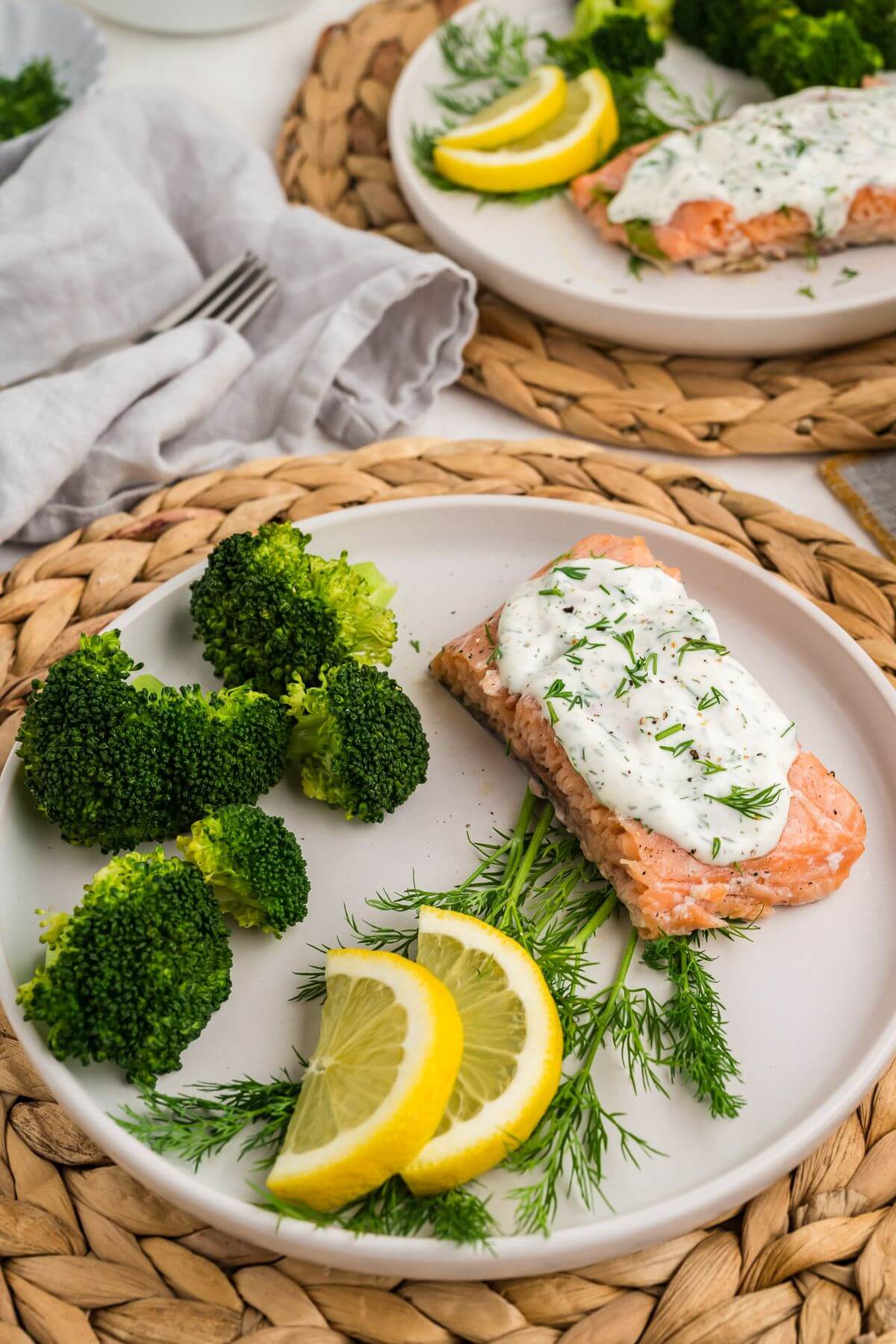
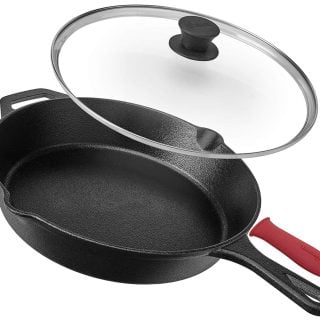
Recommended Tools
- Sous Vide Immersion Circulator – I have the Anova precision cooker
- Zipper-lock bags (freezer bags) or Sous-vide bags
- Vacuum Sealer (optional) while you don’t need one they do make it much easier!
- My favorite Sous Vide cookbook!
Simple Ingredients for Salmon Sous Vide
- Olive oil | You must brush the flaky salmon and sear after cooking. Use olive oil, avocado oil, or any other neutral oil.
- Salt and pepper | Simple seasoning using kosher salt and black pepper. Freshly ground black pepper is always best!
- Salmon | I used fresh salmon fillets with skin on, mine were about 1 inch thick. See below for instructions on how to cook frozen fillets.
- Garnish | With bright lemon slices and delicate sprigs of fresh dill.
- Dill Sauce | You will need mayonnaise, plain Greek Yogurt, lemon juice, garlic and onion powder, dried dill, and fresh dill.
Get the full recipe in the recipe card below.

How to Make Easy Salmon with Dill Sauce
Step 1 | Recipe prep
Get started by filling a large pot of water and setting the sous vide wand to 122°F (50° C), allowing the warm water to come to the correct water temperature (your sous vide wand should tell you when it’s reached the temp).
Make sure to pat the salmon dry with some paper towels, then brush the salmon fillets with olive oil, sprinkling on salt and pepper. Then, place the salmon filets in a single layer in a ziplock bag with a slice of lemon and a fresh dill sprig. Remove all the air from the bag using a vacuum sealer or the water displacement method (see below).
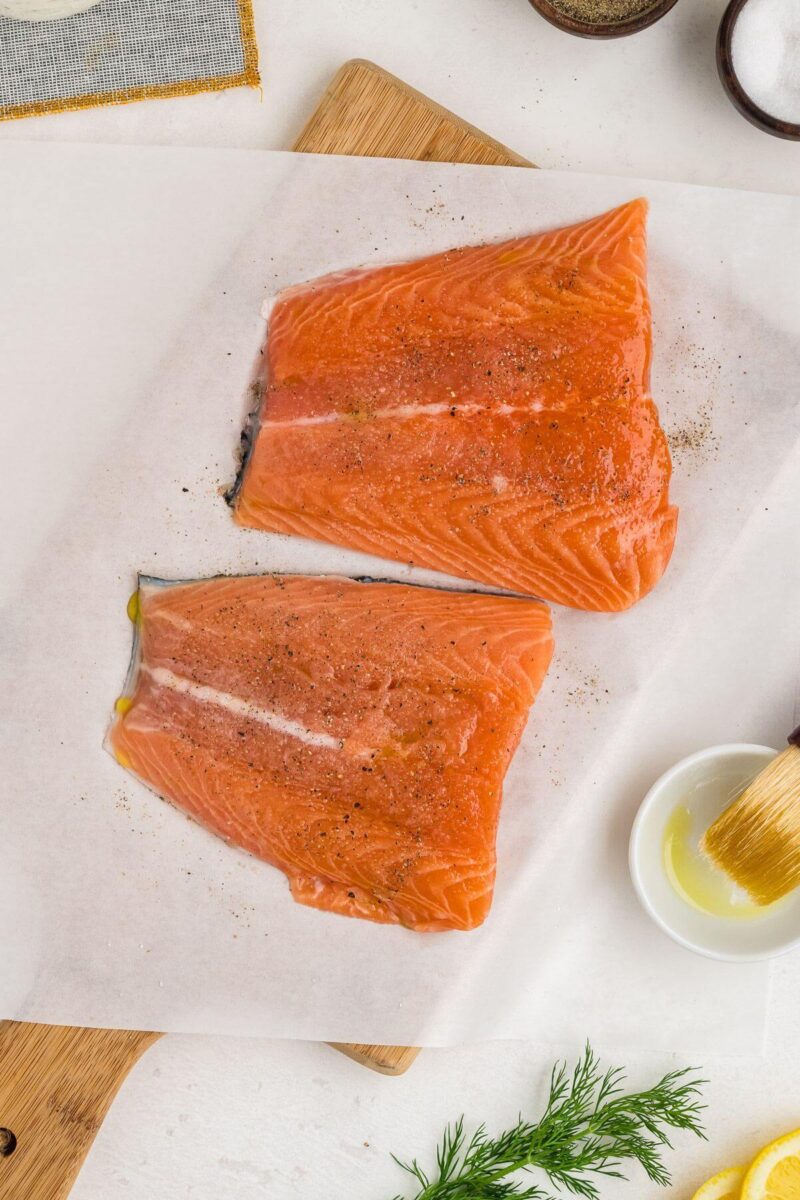
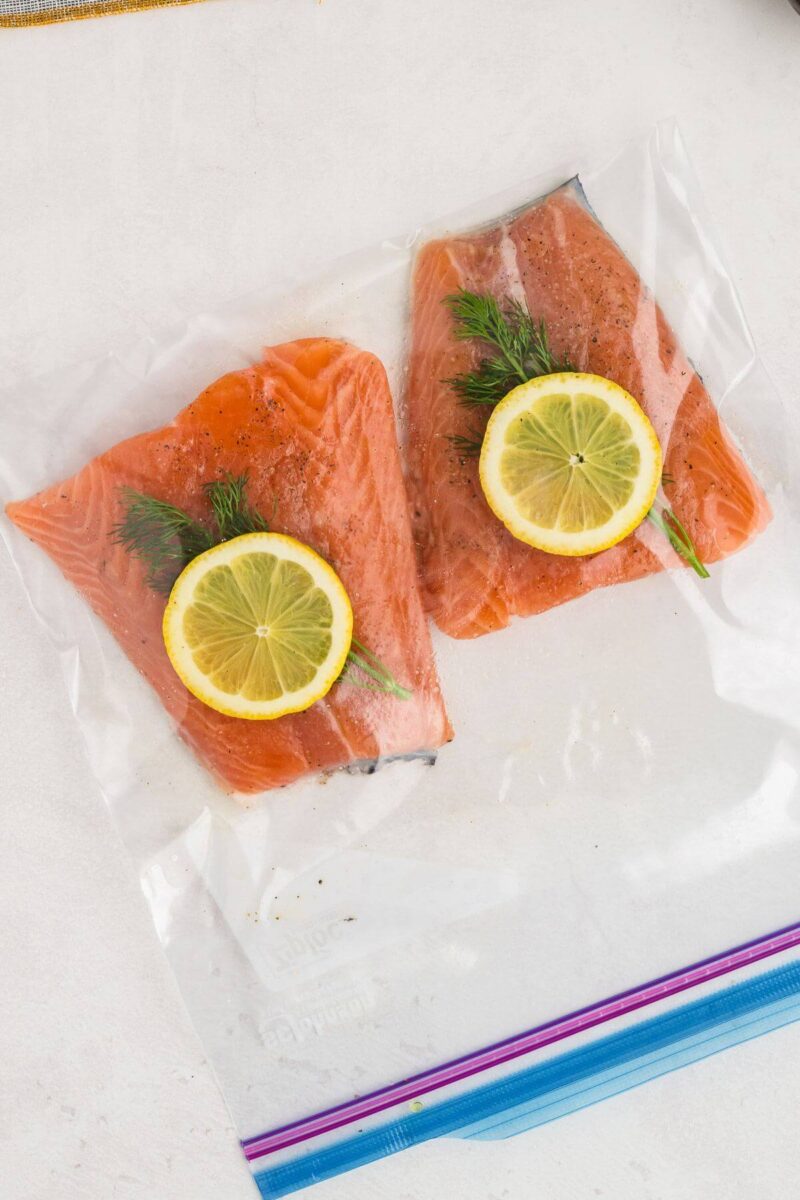
How to do the water displacement method
After setting the salmon and other ingredients into the bag, seal it, leaving one corner open. Then, lower the bag into the water bath, pushing it slowly and carefully to remove the air. Before it submerges completely, seal the last corner. Now, your bag should look like you used a vacuum sealer machine!
Step 2 | Sous vide salmon
Submerge and sous vide the salmon fillets in the preheated water for 40 minutes.
Fresh Tips
- I used 1-inch thick salmon fillets. Remember that different thicknesses will vary in cooking time and adjust accordingly.
- The water bath can be a large pot or container large enough to fit the sous vide bag completely submerged.
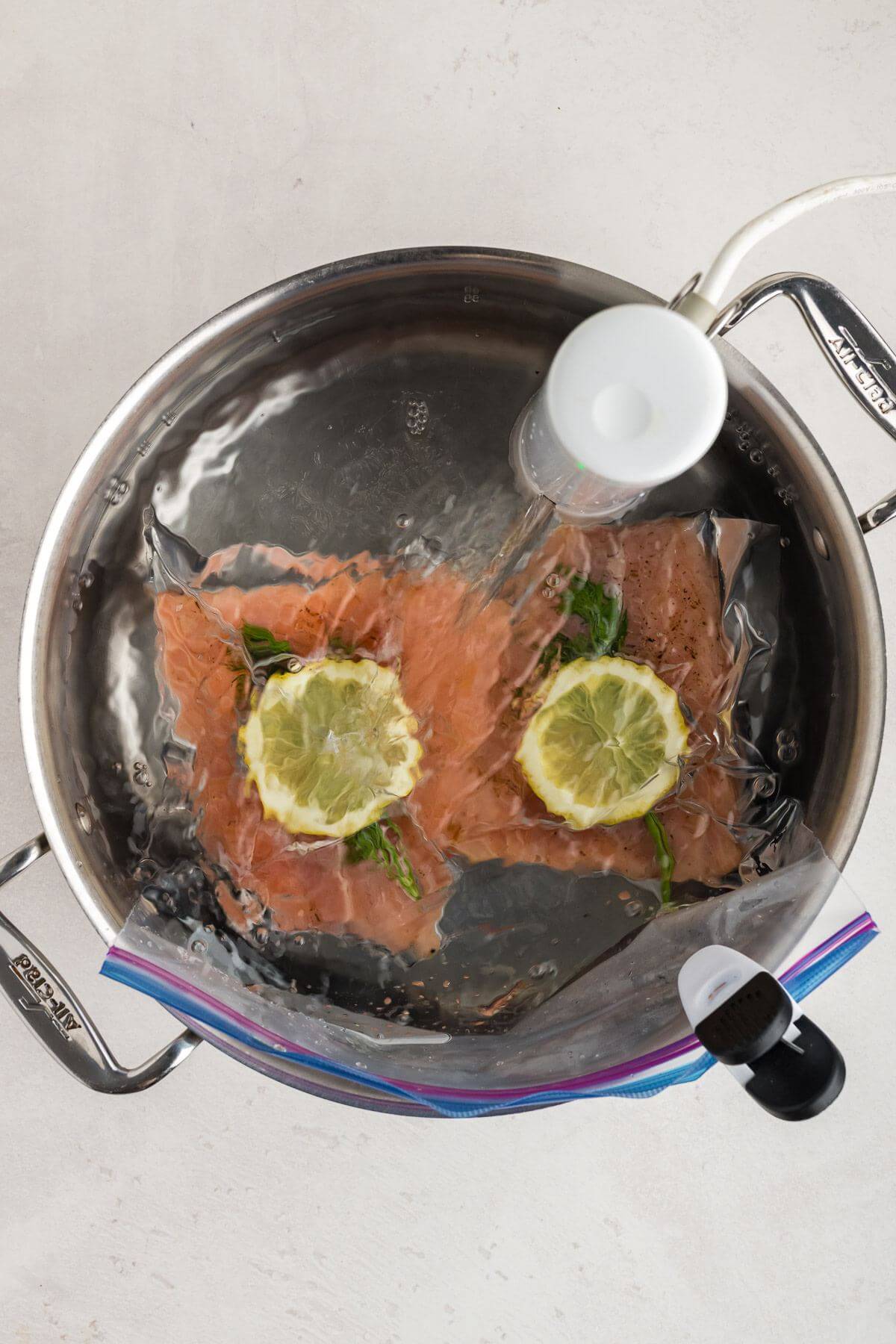
Fresh Tip
- Use a chip clip to secure the bag to the side of the pot keeping it away from the circulator.
Step 3 | Make the dill sauce
In the meantime, combine the mayo, yogurt, lemon juice, garlic powder, onion powder, dried dill, and fresh dill in a small bowl. Mix until the texture is smooth and the sauce ingredients are evenly incorporated. Then, refrigerate the dill sauce until ready to use.
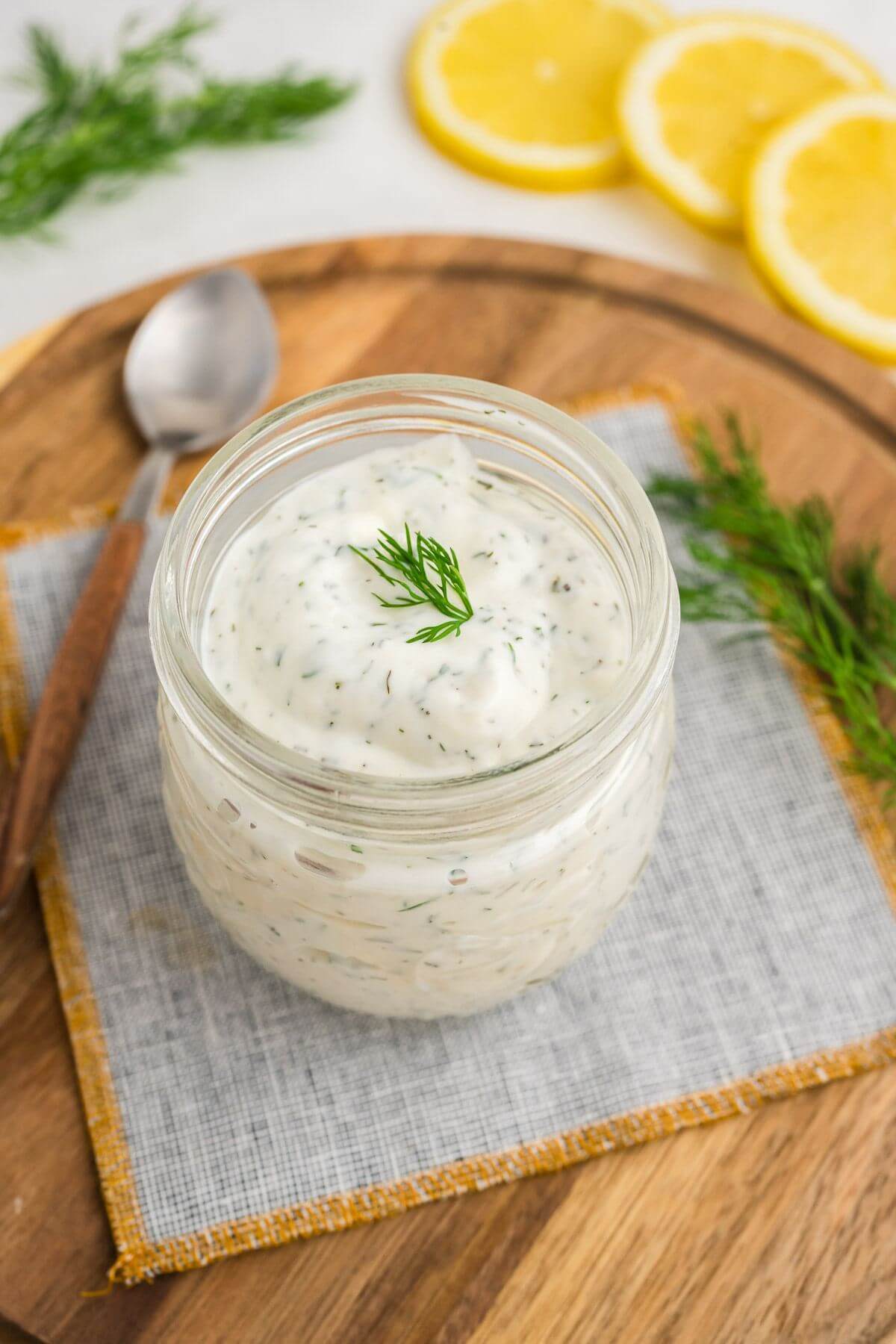
Step 4 | Quick sear, garnish, and serve!
Once the salmon has reached the internal temperature, remove it from the sous vide bath, and allow it to rest for 5 minutes. Then carefully remove it from the bag, and set it on a plate lined with a double layer of paper towels, this is so you can get that crispy salmon skin.
Next, heat a skillet (I used a cast iron skillet) on the stovetop over medium-high heat and add a little olive oil. Sear the salmon skin side down only for 30 to 60 seconds for crispy salmon skin.
Immediately serve the salmon with your homemade dill sauce, a wedge of fresh lemon, and a sprig of fresh dill.

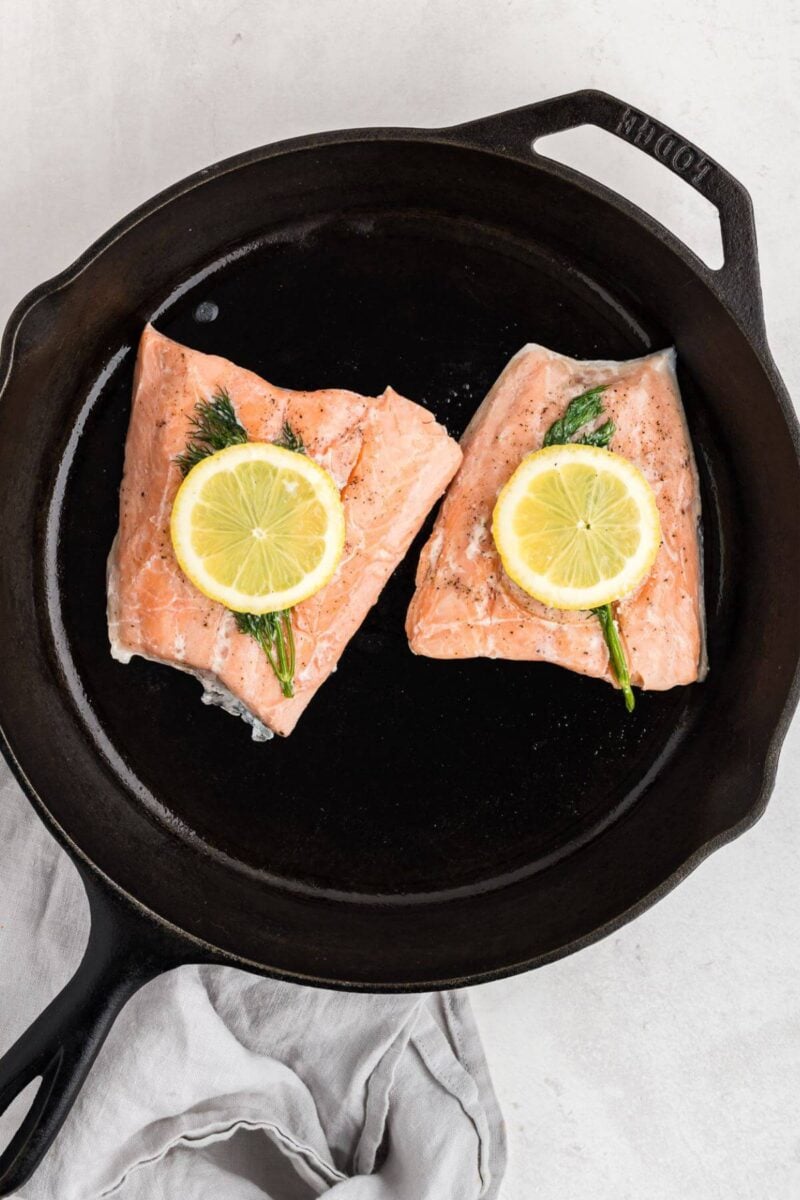
How do you crisp salmon skin after sous vide?
My preferred way to crisp the salmon skin after sous vide is as described above. Pat dry the skin side of the cooked sous vide salmon, then carefully slip the fillets into the hot cast iron pan.
Fresh Tips
- Searing the salmon after cooking is optional but creates delicious and crispy skin and adds flavor. After the sous vide, you usually sear both sides of the meat. However, salmon is a delicate meat and it’s better only to sear the skin side.
Alternative sous vide salmon cooking temperatures
Here is a quick guide based on your desired doneness and texture of salmon:
- Decrease the temperature to 109.9° F (43.3° C) for a heated through with a sushi-like texture.
- My preferred temp: 122° F (50° C) yields a soft texture, fully cooked – my husband loved it this way!
- More firm texture; increase temperature to 126.5° F (43.3° C) for a slightly more firm texture.
- Flakier and firmer texture; increase to 140° F (60° C) but still moist!
I’ve been having tons of fun experimenting with my sous vide machine! It’s an effortless way to get a delicious dinner on the table or provide an impressive meal for friends and family.
If you’re looking for more fool-proof sous vide recipes, try my Sous Vide London Broil, Sous Vide Chicken Breasts, and Sous Vide Boneless Ribeye Steak– Yum!
How to Sous Vide Frozen Salmon
If you’d rather cook from frozen, I’ve got you covered! Follow the recipe as you would with fresh fillets, then cook for an hour and 10 minutes or 70 minutes. If your frozen fillets are thicker than one inch, increase the cooking time accordingly.

Substitutions
This dill sauce is delicious– However, you can get creative with different sauces and flavors!
- Creamy and Cheesy – Gorgonzola Cream Sauce
- Fresh and Herby – Nut-Free Basil Pesto Sauce
- Sweet and Tangy – Homemade Honey Teriyaki Sauce
- Light and Garlicy – Easy Garlic Yogurt Sauce
- Flavorful and Refreshing – Homemade Blender Salsa
- For extra citrus flavor, sprinkle the salmon fillets with fresh lemon zest.
- Chipotle pepper is another excellent seasoning for the tender salmon if you prefer a little more flavor.
Can I brine salmon before sous vide?
Yes, it will add flavor and firm the texture of the salmon, and reduce the chances of that white ooze that can appear on cooked fish. It’s a sciency thing – something to do with albumens.
How to make a brine
- 2 cups water, ¼ cup salt, 1 tablespoon sugar (optional).
- Mix the above ingredients together in a small bowl, stirring until dissolved. Place salmon filets in a freezer ziplock baggie, add the brine, seal the bag and let rest in the fridge 20-30 minutes. When ready to sous vide, leave the fish in a bag, drain the brine, and add oil to the bag, rubbing it all over the fish. Sous vide to desired temperature.
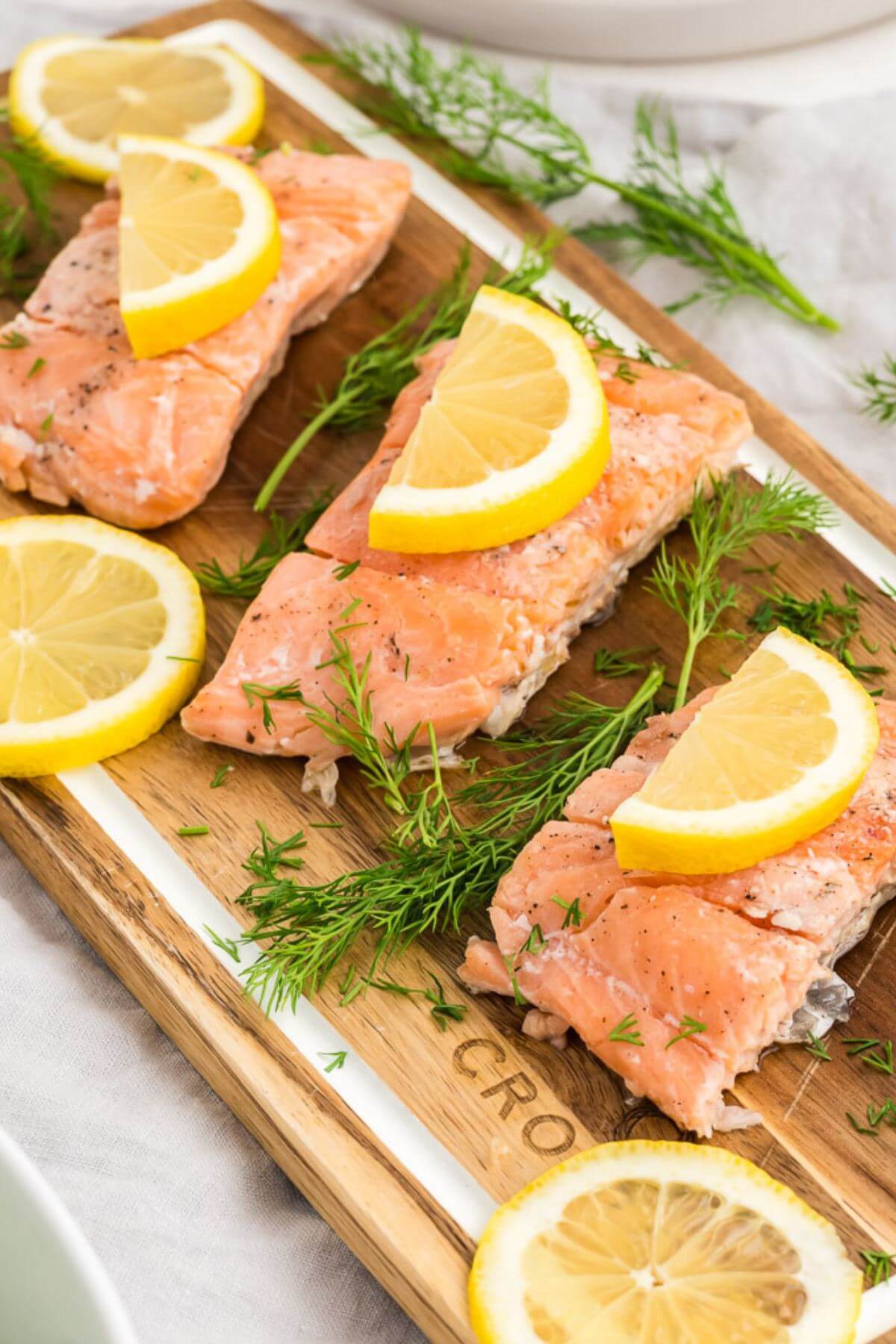
Make Ahead Sous Vide Salmon
This is the beauty of the sous vide cooking process: You can cook your salmon perfectly and save it for later.
If you’re making this salmon recipe in advance to heat later for a quick dinner or lunch, here’s what you need to do: Once completely cooked, add the vacuum-packed salmon to an ice bath immediately. Once chilled, it may be stored in the refrigerator for up to 4 days or frozen for up to 1 month. If you open the bag, be sure to remove as much air as possible before freezing.
Quickly chilling the salmon in cold water halts the cooking process and avoids overcooking when you reheat it later.

How to reheat sous vide salmon
Reheating sous vide salmon is a delicate process to ensure it remains tender and flavorful. Here’s a simple step-by-step guide to do it:
- Back into the sous vide: My preferred way is to slip it back into the sous vide pot. Allow the salmon to come to room temperature for about 10-15 minutes. Preheat water to 122° F (50° C), make sure it’s vacuum-sealed, then submerge and reheat for 10-15 minutes. Carefully remove the salmon and pat dry, then if desired pan fry skin side only for 1-2 minutes until the skin is crispy.
- Enjoy it cold in a salad and don’t do a thing!
- Oven Method: Preheat your oven to 275°F (135°C). Place the salmon fillets on a parchment-lined baking sheet. Cover the salmon loosely with foil to prevent drying out. Reheat in the oven for about 10-15 minutes, or until warmed through.
- Pan Method: Heat a non-stick skillet over medium heat. Add a small amount of oil or butter to the skillet. Once the skillet is hot, place the salmon fillets skin-side down if they have skin. Cook for 2-3 minutes on each side until heated through.
- Microwave Method: Place the salmon fillets on a microwave-safe plate. Cover loosely with a damp paper towel to prevent drying. Microwave on medium power (50-70%) for about 1-2 minutes, checking periodically to avoid overheating. Let the salmon sit for a minute or two before serving to ensure even heating.

Frequently Asked Questions
Seasoning is never required, but it is the best way to enhance the flavor of the fish. Salmon is packed with delicious flavor, so salt, pepper, citrus, and fresh herbs usually do the trick. However, you can also use your favorite salmon seasoning from the grocery store.
It’s best to cook sous vide salmon between 115-125°F to preserve moisture and texture.
While the final salmon should reach an internal temperature of 145°F, you can make the fillets at a lower temperature for a longer cook time for extra tender and flaky fish. Use a meat thermometer to check the doneness.
It’s always possible to overcook salmon with all the cooking methods. However, the sous vide method is known for being challenging to overcook foods due to its precise cooking temperature. Leaving the salmon in the water bath for too long can make the fillets mushy and overcooked, so follow the recipe instructions closely.
Vacuum sealers are extremely helpful but not necessary when cooking sous vide. Instead, you can use the displacement method to get as much air as possible from the plastic bag before adding it to the water bath.
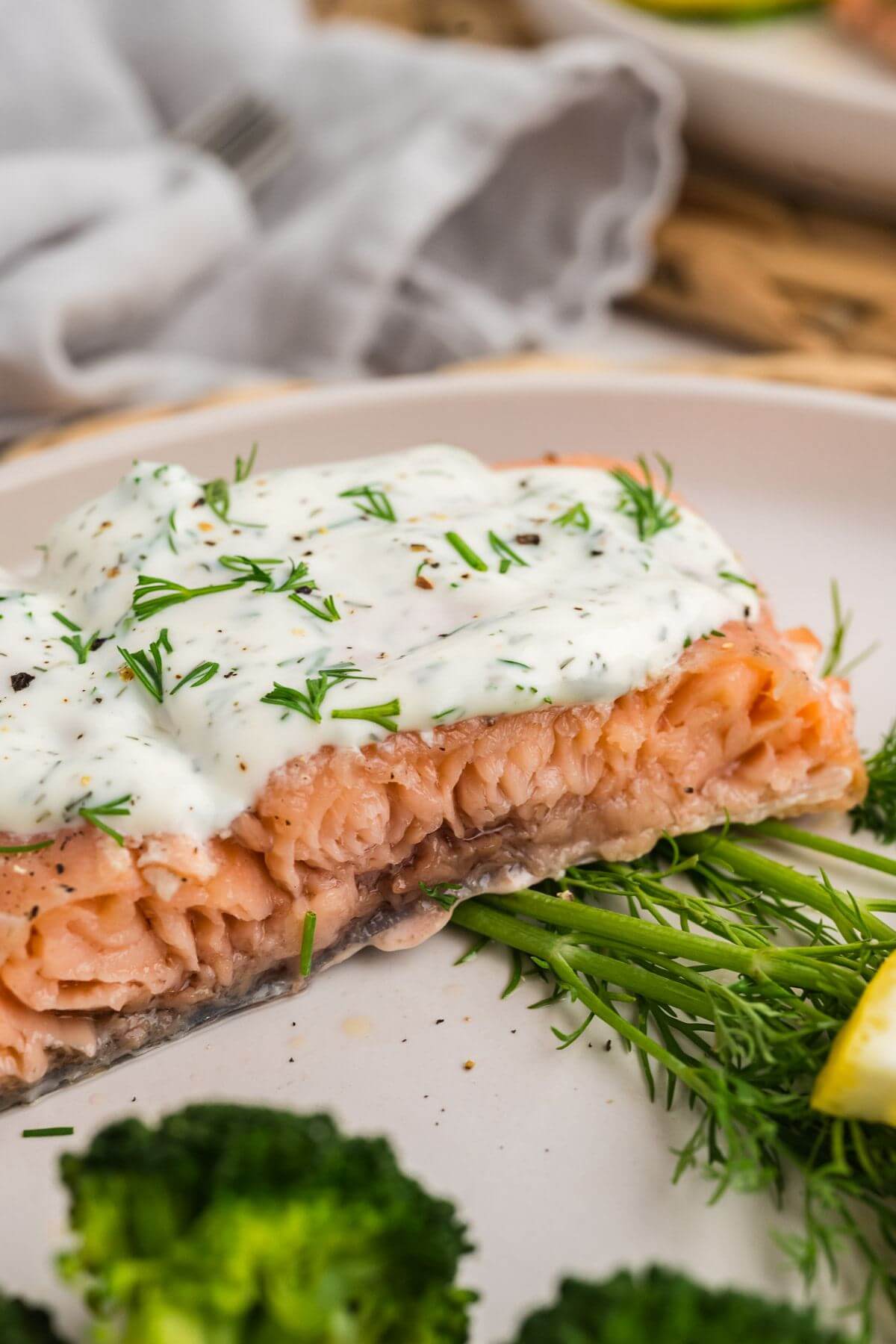
What to serve with Salmon with Lemon Dill Sauce
- Cilantro Lime Rice {A Chipotle Copycat}
- Air Fryer Asparagus Recipe
- Roasted Brussels Sprouts with Honey Balsamic Glaze
- Roasted Rosemary Red Potatoes
Best sides to serve with sous vide salmon
Here are a few of our favorite sides to enjoy with salmon sous vide! Go simple and steam or roast some broccoli or air fry asparagus or go fancy and make this roasted broccoli and sweet potatoes or for a great low-carb meal, make this broccoli cauliflower casserole.
Cheesy Broccoli Cauliflower Casserole (Vegetable Au Gratin)
As we enter the holiday season, easy side dishes are a must and slam-dunk recipes like this vegetable au gratin are always a winner. You will also love my broccoli gratin, potatoes au gratin and this not your Grandma’s Green Bean Casserole.
Crispy Oven Roasted Sweet Potatoes and Broccoli
Beautifully seasoned and oven roasted to perfection, these healthy crispy Roasted Sweet Potatoes and Broccoli recipe is a game-changer for weeknight meals. The prep is quick, and it only takes about 30 minutes for the veggies to roast.
Air Fryer Asparagus Recipe
This Air fryer asparagus recipe is a healthier and easier way to prepare garden fresh asparagus. A fresh and healthy veggie side dish with simple seasonings for amazing flavor and beautiful presentation.
Best bread to serve with sous vide salmon
While adding bread wouldn’t be low-carb, life is bread! So try a few of our favorites! Since this salmon sous vide is so simple, make these easy yeast rolls for beginners, try a quick 4-ingredient Irish soda bread or these 2 ingredient biscuits!
2 Ingredient Biscuits
Easy Homemade Biscuits. This easy 2 ingredient biscuit recipe without baking powder produces flaky biscuits that turn out tender, moist, and flaky with just TWO ingredients.
4-Ingredient Irish Soda Bread
Traditional 4 ingredient Irish Soda Bread is the best easy recipe to make from scratch. A dense, crusty, hearty bread recipe from Ireland. Gluten free option too!
Easy Yeast Rolls for Beginners
Light, fluffy, piping hot, no knead easy yeast rolls for beginners! Easily started in your bread machine, then finish in the oven, for perfect, hot, soft buttery yeast rolls. These are the ideal rolls for beginner breadbakers!
More Complimentary Sauce and Entree Recipes
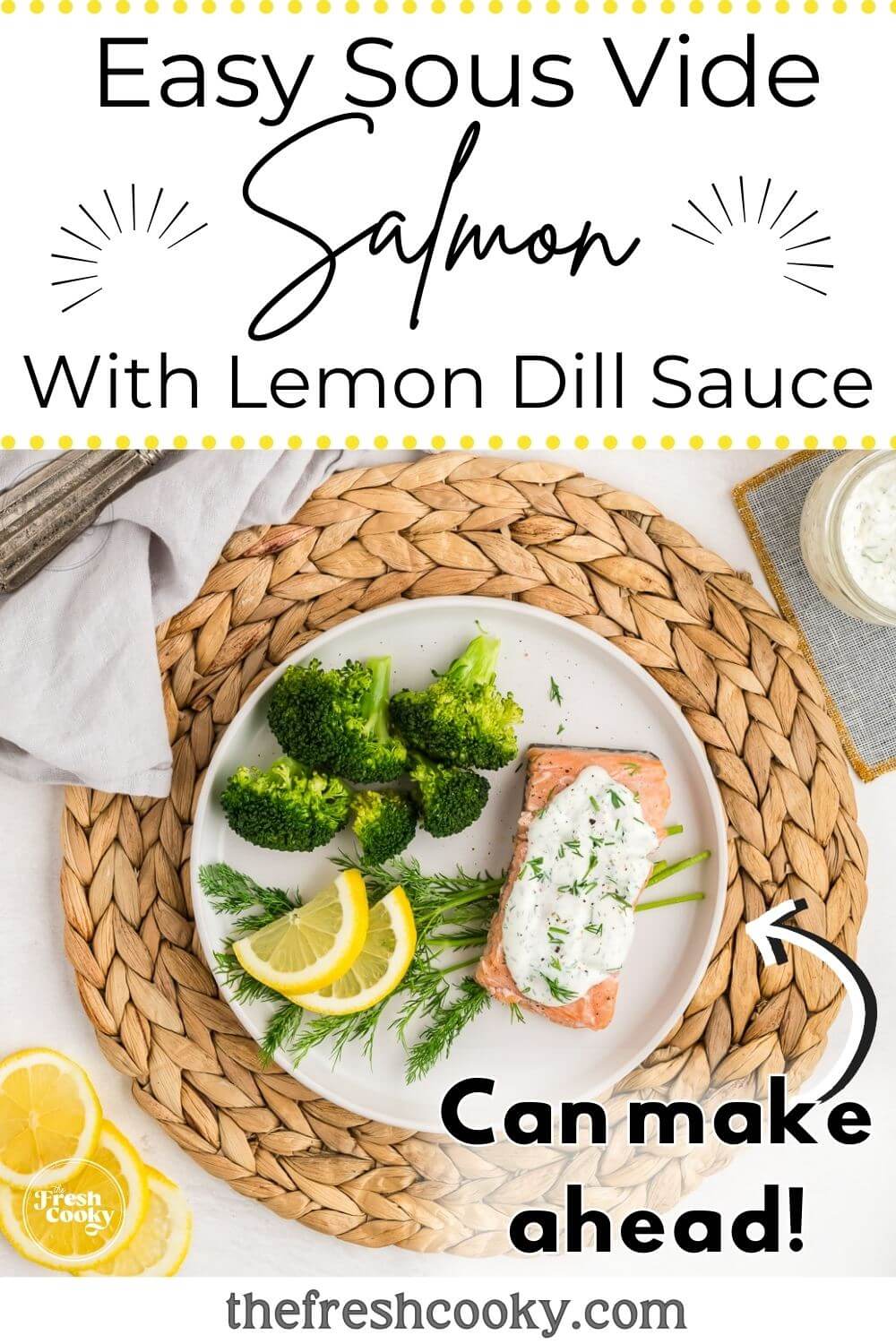
Patience plays a big role in sous vide cooking. So, take your time! Let the salmon cook at the recommended temperature for the right time for the best results.
Did you love this Sous Vide Lemon and Dill Salmon Recipe? If you did, please share your creation on Instagram, Facebook, and Pinterest? Don’t forget to rate and comment on the recipe card below.
Like this recipe?
Don’t forget to give it a ⭐️⭐️⭐️⭐️⭐️ star rating and leave a comment below the recipe!

Sous Vide Salmon Recipe with Dill Sauce
Click stars to rate now!
Print Pin Save RateIngredients
- 1 teaspoon olive oil olive oil, avocado oil or other neutral oil may be used
- 1 teaspoon kosher salt
- ¼ teaspoon black pepper
- 4 salmon fillets 1 inch thick
- 4 lemon slices
- 4 sprigs fresh dill Fresh dill is best for this recipe, in a pinch sprinkle dried dill over the top.
Lemon Dill Sauce
- ¾ cup mayonnaise use a high-quality mayonnaise, I love Chosen Avocado Mayo
- ¾ cup plain Greek yogurt whole fat
- 1 tablespoon lemon juice fresh squeezed
- ½ teaspoon garlic powder
- ¼ teaspoon onion powder
- 1 teaspoon dried dill
- ¼ cup fresh dill minced
Instructions
- In a large pot, fill with warm water and set the sous vide machine to 122° F (50° C) — *see notes for different cooking temperatures.
- Brush the salmon (4 fillets) with olive oil (1 tsp), and season with salt (1 tsp) and pepper (¼ tsp).
- Place it in the bag and put a lemon slice and dill sprig on top. Release all the air out of the bag and seal it. If you are having trouble getting all the air out, use the displacement method (see notes). Alternatively, you can use vacuum seal bags with a sealer.
- Cook the salmon in the water bath for 40 minutes.
Prepare lemon dills sauce
- While the salmon is cooking, prepare the dill sauce. In a small bowl, combine the mayo (¾ cup), yogurt (¾ cup), lemon juice (1 TBL), garlic powder (½ tsp), onion powder (¼ tsp), dried dill (1 tsp)and fresh dill (¼ tsp) and stir until smooth and incorporated. Refrigerate until needed.
- After the cooking time, carefully take the salmon out of the bag and set on a plate. Preheat a skillet to very hot (over medium-high heat), and sear the salmon, skin side down, for 30-60 seconds. **This is optional, the salmon will be fully cooked when it comes out of the sous vide bath, if you sear in skillet, it's to crisp the skin.
- Serve with lemon dill sauce, a wedge of lemon and a sprig of dill.
Notes
Sous vide salmon cooking temperatures
Here is a quick guide based on your desired doneness and texture of salmon:- Decrease the temperature to 109.9° F (43.3° C) for a heated through with a sushi-like texture.
- My preferred temp: 122° F (50° C) yields a soft texture, fully cooked – my husband loved it this way!
- More firm texture; increase temperature to 126.5° F (43.3° C) for a slightly more firm texture.
- Flakier and firmer texture; increase to 140° F (60° C) but still moist!
- My salmon fillets were 1 inch thick; cook time will vary depending on thickness.
- We cooked fresh salmon; you can also start with frozen salmon. Frozen salmon at 1 inch thick will cook for 1 hour and 10 minutes.Searing is optional, but gives a great crust and added flavor,
- Typically with sous vide recipes, we sear both sides of the meat, but in this case with salmon being so delicate and not wanting to overcook, we only seared the skin side.
- Displacement method: Seal all but one corner of the bag containing the salmon. Lower it into the water bath, using a spoon, gently push the bag further in so the air in the bag naturally works its way out. When almost fully submerged, seal the corner.
Storage Tips
Store leftover salmon and dill sauce separately in an airtight container in the fridge for 1-2 days, see below for tips on reheating. See post for make-ahead and reheating tips! EXPERT TIPS:- Patience is Key: Unlike traditional cooking methods, sous vide requires patience. Allow the salmon to cook for the recommended time (usually 30-60 minutes), ensuring it reaches the desired internal temperature without rushing the process.
- If you’re making ahead, once cooked, rapidly chill the salmon in an ice bath for a few minutes. This halts the cooking process and prevents the fish from becoming
overcooked while maintaining its delicate texture. - Finishing touches- Searing the meat in a hot skillet or grill adds that extra depth of flavor and gives a nice caramelized crust on the meat.
- Get Creative! Pair your sous vide salmon with complementary flavors such as our
creamy dill sauce, citrus-infused salsa, or a fresh herb salad to elevate the dish further.
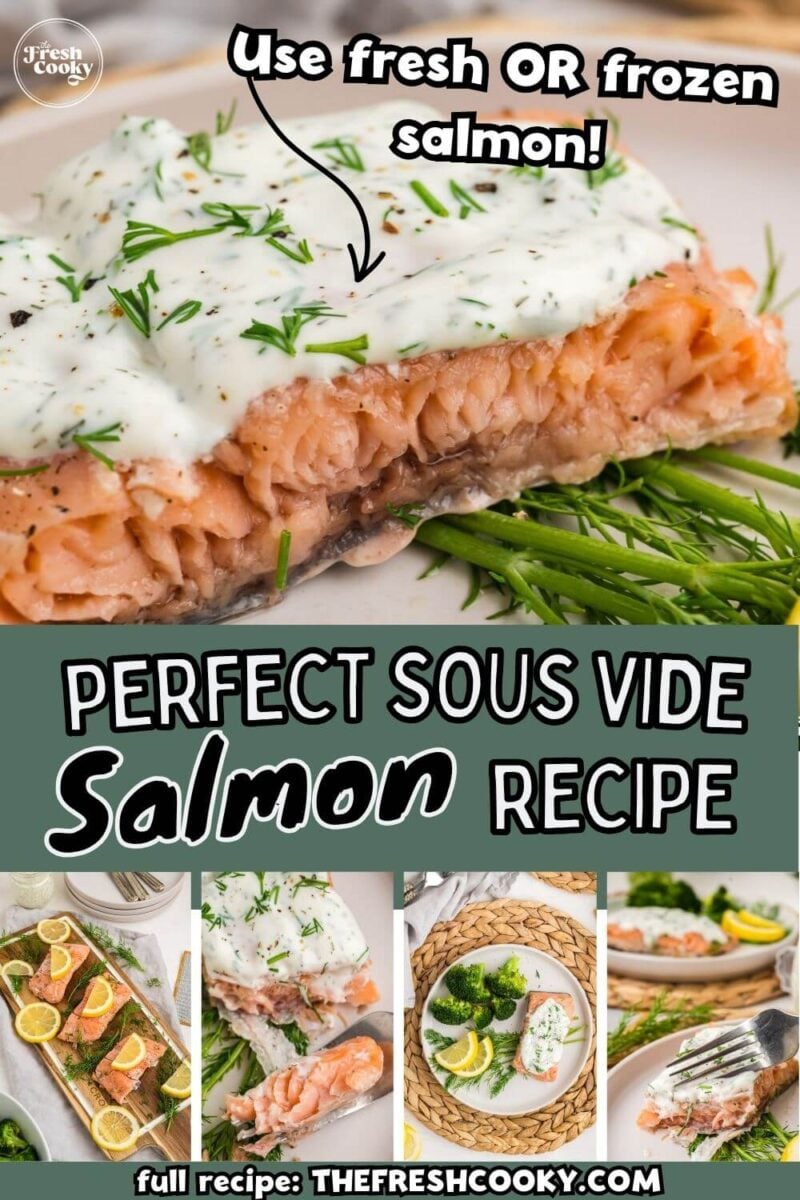

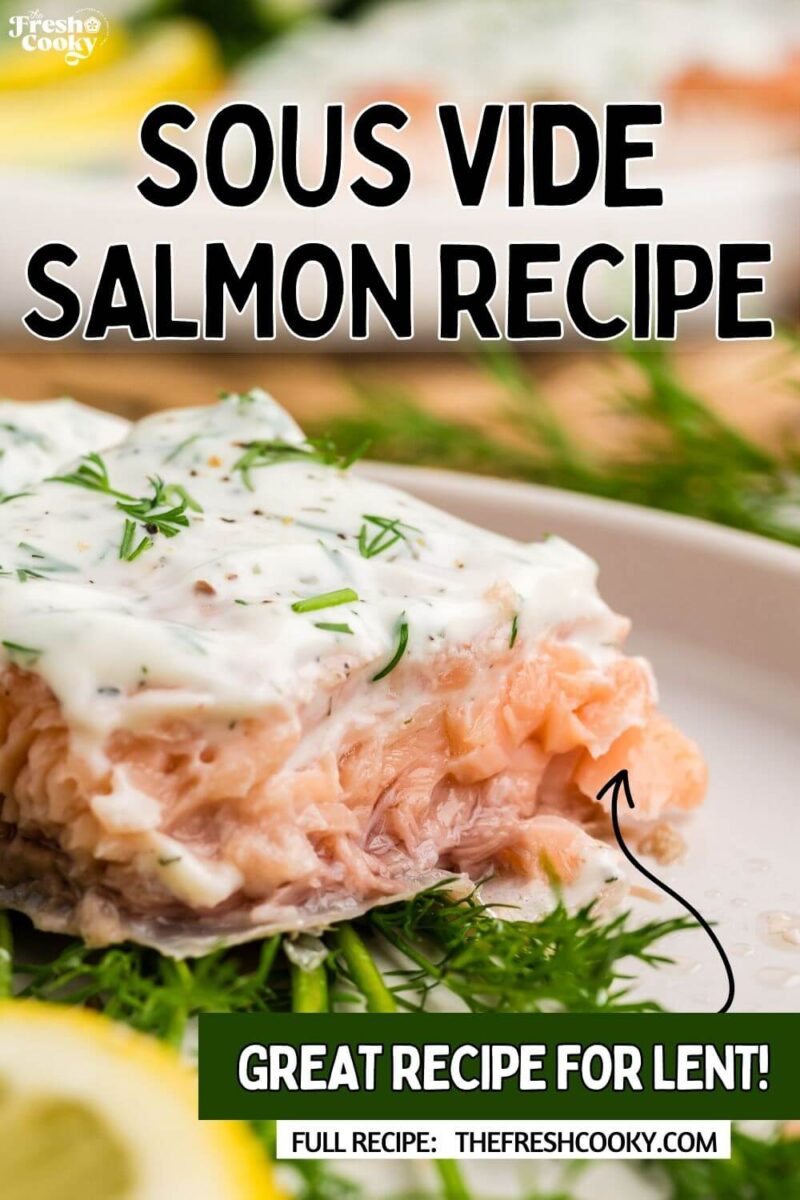


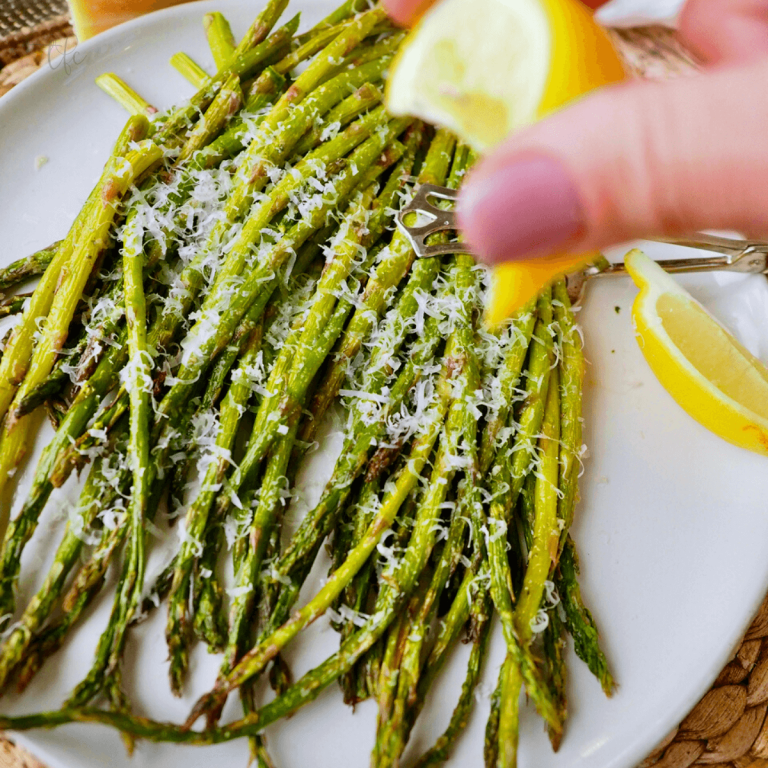


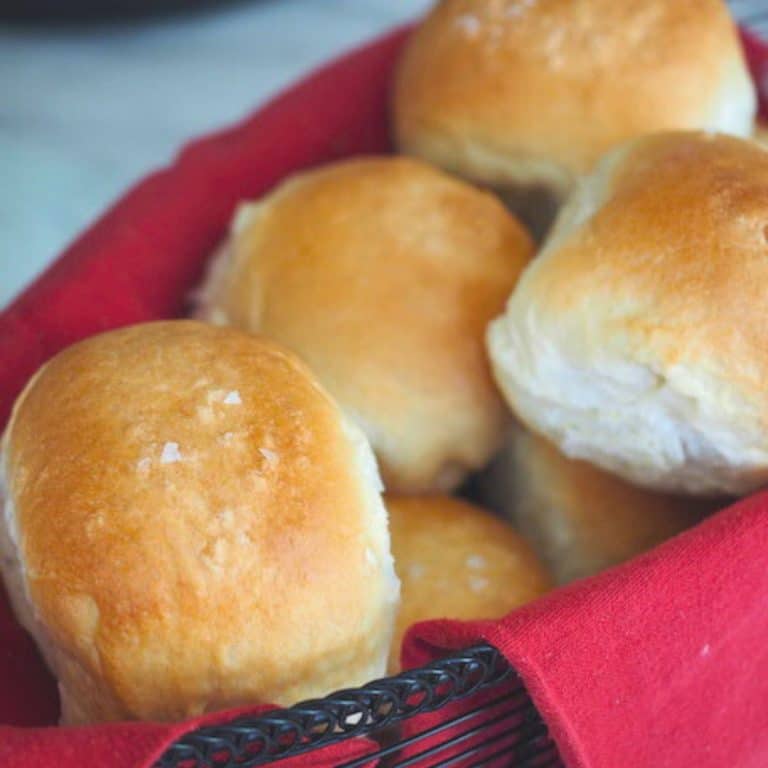


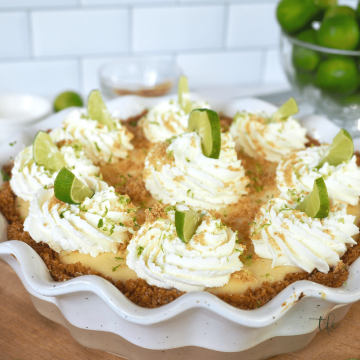




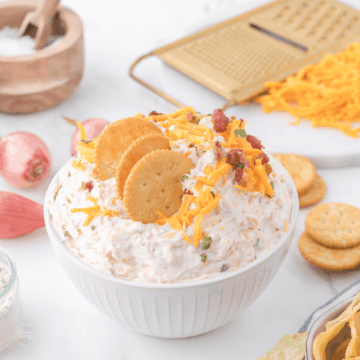
Salmon and dill is such a delicious flavour combination and this was such an easy way to cook it.
Thank you so much!
This is my new favorite salmon recipe! Super flavorful and perfectly flaky!
Glad you liked it Tayler!
What a beautiful sauce! We love salmon and I’m a huuuuuge dill fan so this was a hit.
So glad to hear that Dana, thank you so much!
My salmon turned out perfectly cooked! The dill sauce was a delicious addition to the dish. I will definitely be making this recipe again.
So glad to hear that Sky! Thanks!!
This looks amazing and such a treat! Thank you!
Thank you!
This salmon was incredible! Love the flavors!
So glad you loved it!! Thanks Laura!
This dish felt so light and springy! Love the flavors!!
Amazing aren’t they!?